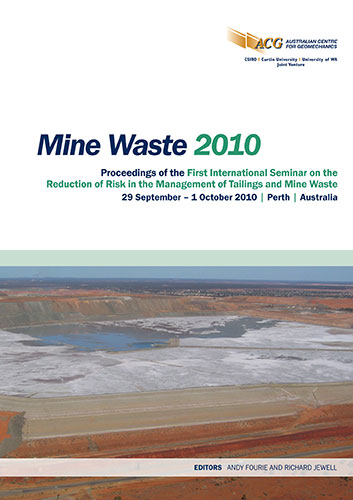Effectiveness in risk assessment — a comparison of perceived and realised risk from project concept to construction and operation

|
Authors: Murray, L; McLeod, H; Suter, G |
DOI https://doi.org/10.36487/ACG_rep/1008_19_Murray
Cite As:
Murray, L, McLeod, H & Suter, G 2010, 'Effectiveness in risk assessment — a comparison of perceived and realised risk from project concept to construction and operation', in R Jewell & AB Fourie (eds), Mine Waste 2010: Proceedings of the First International Seminar on the Reduction of Risk in the Management of Tailings and Mine Waste, Australian Centre for Geomechanics, Perth, pp. 217-228, https://doi.org/10.36487/ACG_rep/1008_19_Murray
Abstract:
Tailings and waste rock disposal is rightly seen as one of the major short and long-term risks associated with mining. High profile catastrophic failures of dams and waste dumps make international headlines all too often. Risk assessments, often done in a workshop format, are one of the main tools whereby designers, operators and owners seek to identify and mitigate hazards and their associated consequences. The authors have been undertaking risk assessments, using failure modes and effects analysis (FMEA), on mine waste disposal projects since the early 1990s, in many different environments and in many different parts of the world. From that collective experience, this paper looks back at the risk assessments for a series of case histories where designs have developed into built waste management facilities. With the benefit of hindsight the paper reviews what has worked, what has not worked and whether serious hazards had gone unnoticed. The selected case histories involve mine developments in remote locations, in high rainfall, high seismic and weak soil environments. Because the sites are in hazardous environments, the operations have been exposed to most of the classic tailings storage facility risks, indeed the sites have experienced some large events without undue damage. The design risks are relatively easily quantifiable and with careful consideration can be minimised and allowed for. The paper also identifies some ‘soft’ risks, for example management and project controls. The importance of having a management team that understands the design limitations and is committed to the safe and long-term design of the structures is immensely important. An example is also given as to how FMEA is used in business practice. Conclusions are presented which may help others in dealing with risk and uncertainty in hazardous environments.
© Copyright 2025, Australian Centre for Geomechanics (ACG), The University of Western Australia. All rights reserved.
View copyright/legal information
Please direct any queries or error reports to repository-acg@uwa.edu.au
View copyright/legal information
Please direct any queries or error reports to repository-acg@uwa.edu.au